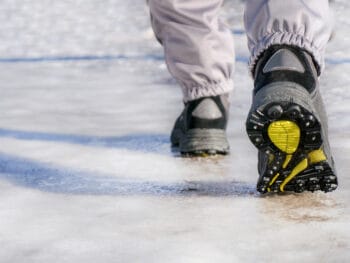
While you might not have control over the weather, you can at least control the risks faced by your employees. And you don’t necessarily have to spend a lot to reduce or even eliminate many weather-related workers’ comp claims.
Here’s a look at how to prevent the most frequent — and preventable — cause of seasonal claims.
Slippery Slopes
Icy, wet pavement and floors can wreak havoc for workers. Whether inside or outside, employers should seek to have the driest, safest surfaces for their employees.
Clear Snow & Ice
The most obvious solution for preventing slip and fall injuries in winter is to make sure snow and ice are cleared from all walkable surfaces and salt or other deicing material is laid down.
This includes sidewalks, entryways and parking lots. While state laws vary on whether injuries in outdoor areas are compensable through workers’ comp, making them safer can protect your employees as well as vendors and other visitors to your facility.
Place Signage Warning of Slippery Floors
In areas such as doorways, it’s also smart to place signage warning of slippery floors. Absorbent mats are another method to help keep inside walkways dry. Good lighting should also be considered for areas where floors and pavements can be slippery.
Instruct Workers To Wear Footwear With Good Traction
Workers who are more likely to be outside should be given, or instructed to wear footwear with good traction, such as slip resistant shoes or boots. They should also be informed that taking shorter steps and walking slower will help them react better to sudden slippery spots.
Place Ladders Only On Cleared Surfaces
Workers who have to be on elevated surfaces, such as roof tops need to take extra precautions. They should be provided and trained on fall protection methods. Ladders should be placed only on surfaces that have been cleared of snow and ice. Where possible, outside vendors should be employed to remove snow from roofs and other areas.
Conclusion
Employers should try to avoid sending workers outside in frigid temperatures and where snow or ice is problematic. Scheduling work for the warmest part of the day is advisable. For employees who must work outside, they should be trained about the injuries and illnesses that can affect them and understand the hazards of any equipment they may use, such as snow blowers.
For additional information on workers’ compensation cost containment best practices, register as a guest for our next live stream training.

Contact: mstack@reduceyourworkerscomp.com.
Workers’ Comp Roundup Blog: https://blog.reduceyourworkerscomp.com/
Live Stream WC Training: http://workerscompclub.com/livestreamtraining.com
©2017 Amaxx LLC. All rights reserved under International Copyright Law.
Do not use this information without independent verification. All state laws vary. You should consult with your insurance broker, attorney, or qualified professional.














